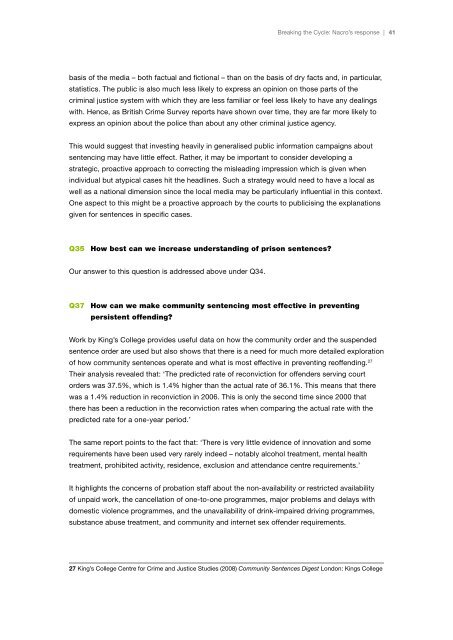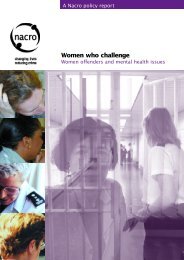Nacro's response to Breaking the Cycle Green Paper
Nacro's response to Breaking the Cycle Green Paper
Nacro's response to Breaking the Cycle Green Paper
Create successful ePaper yourself
Turn your PDF publications into a flip-book with our unique Google optimized e-Paper software.
<strong>Breaking</strong> <strong>the</strong> <strong>Cycle</strong>: Nacro’s <strong>response</strong> | 41basis of <strong>the</strong> media – both factual and fictional – than on <strong>the</strong> basis of dry facts and, in particular,statistics. The public is also much less likely <strong>to</strong> express an opinion on those parts of <strong>the</strong>criminal justice system with which <strong>the</strong>y are less familiar or feel less likely <strong>to</strong> have any dealingswith. Hence, as British Crime Survey reports have shown over time, <strong>the</strong>y are far more likely <strong>to</strong>express an opinion about <strong>the</strong> police than about any o<strong>the</strong>r criminal justice agency.This would suggest that investing heavily in generalised public information campaigns aboutsentencing may have little effect. Ra<strong>the</strong>r, it may be important <strong>to</strong> consider developing astrategic, proactive approach <strong>to</strong> correcting <strong>the</strong> misleading impression which is given whenindividual but atypical cases hit <strong>the</strong> headlines. Such a strategy would need <strong>to</strong> have a local aswell as a national dimension since <strong>the</strong> local media may be particularly influential in this context.One aspect <strong>to</strong> this might be a proactive approach by <strong>the</strong> courts <strong>to</strong> publicising <strong>the</strong> explanationsgiven for sentences in specific cases.Q35 How best can we increase understanding of prison sentences?Our answer <strong>to</strong> this question is addressed above under Q34.Q37 How can we make community sentencing most effective in preventingpersistent offending?Work by King’s College provides useful data on how <strong>the</strong> community order and <strong>the</strong> suspendedsentence order are used but also shows that <strong>the</strong>re is a need for much more detailed explorationof how community sentences operate and what is most effective in preventing reoffending. 27Their analysis revealed that: ‘The predicted rate of reconviction for offenders serving cour<strong>to</strong>rders was 37.5%, which is 1.4% higher than <strong>the</strong> actual rate of 36.1%. This means that <strong>the</strong>rewas a 1.4% reduction in reconviction in 2006. This is only <strong>the</strong> second time since 2000 that<strong>the</strong>re has been a reduction in <strong>the</strong> reconviction rates when comparing <strong>the</strong> actual rate with <strong>the</strong>predicted rate for a one-year period.’The same report points <strong>to</strong> <strong>the</strong> fact that: ‘There is very little evidence of innovation and somerequirements have been used very rarely indeed – notably alcohol treatment, mental healthtreatment, prohibited activity, residence, exclusion and attendance centre requirements.’It highlights <strong>the</strong> concerns of probation staff about <strong>the</strong> non-availability or restricted availabilityof unpaid work, <strong>the</strong> cancellation of one-<strong>to</strong>-one programmes, major problems and delays withdomestic violence programmes, and <strong>the</strong> unavailability of drink-impaired driving programmes,substance abuse treatment, and community and internet sex offender requirements.27 King’s College Centre for Crime and Justice Studies (2008) Community Sentences Digest London: Kings College
















